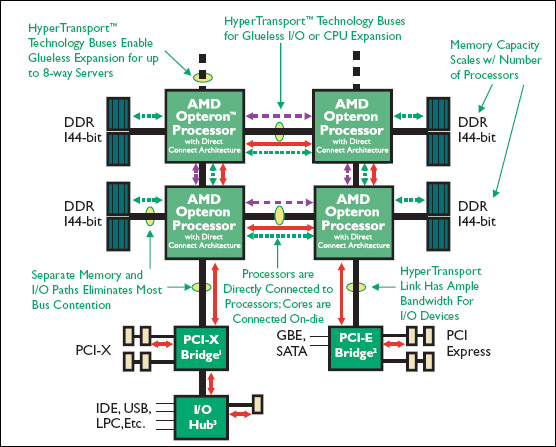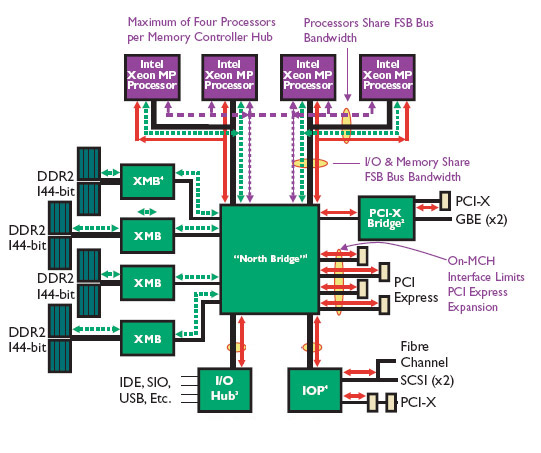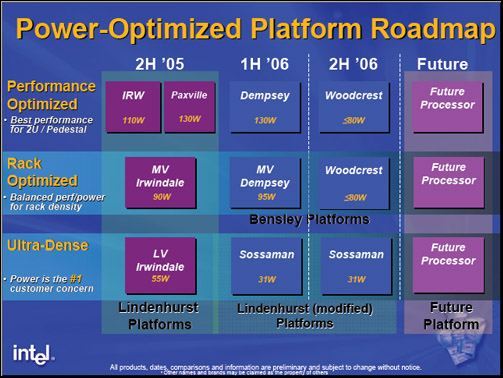Eight Core Servers: Opteron 880 (Egypt) vs. Xeon MP 3.0 GHz (Paxville)
by Jason Clark on April 24, 2006 2:00 AM EST- Posted in
- IT Computing
What do we have today?
The current AMD platform hasn't changed much at all; the only change has really been the move to 1GHz HyperTransport. The K8 architecture is fairly old news now, but is certainly still more scalable and higher performing than Intel's offerings. Intel hasn't made any significant changes, though the E8500 chipset does use a dual shared bus instead of a single bus from the older Xeon MP chipsets. The shared bus helps the bandwidth bottleneck, but with more than 4 processor cores scalability really starts to slow. The diagrams below give a high level overview of the 4P architecture that AMD and Intel currently offer.
Current 4P Architecture


AMD Server Processor Roadmap
As we mentioned, there haven't been any changes to Opteron recently, besides a speed bump and a move to 1GHz HyperTransport last year. Although the Opteron is getting up there in years, it's still a proven, scalable architecture. AMD does have some changes on the horizon for Opteron, though: DDR2 and a new socket. Will that be enough to keep them on top when Woodcrest is released? Only time will tell, but if our recent preview of socket AM2 performance is any indication, changing the server platforms to DDR2 isn't likely to increase performance much over current offerings.
We haven't seen any indications of pending changes other than the socket and memory controller. AMD is being very tightlipped about their plans for Opteron, but below is a synopsis of what we know is on the books.
Highlights
Intel Server Processor Roadmap
Intel has actually been quite forthcoming about what they are working on, for obvious reasons. They need the market to know that they are going to be competitive, and how that will be accomplished. The first two quarters of 2006 will introduce the Bensley platform, which brings the Dempsey Dual Core Xeons.
The last two quarters of the year are where things get interesting. Woodcrest is to debut in the second half of this year. Woodcrest is supposed to drop power consumption from 130W (Dempsey) to <80W, which should make a huge impact on the power consumption numbers we measured earlier this year for Dempsey. Note that Woodcrest processors will also run on the Bensley platform.

The current AMD platform hasn't changed much at all; the only change has really been the move to 1GHz HyperTransport. The K8 architecture is fairly old news now, but is certainly still more scalable and higher performing than Intel's offerings. Intel hasn't made any significant changes, though the E8500 chipset does use a dual shared bus instead of a single bus from the older Xeon MP chipsets. The shared bus helps the bandwidth bottleneck, but with more than 4 processor cores scalability really starts to slow. The diagrams below give a high level overview of the 4P architecture that AMD and Intel currently offer.
Current 4P Architecture


AMD Server Processor Roadmap
As we mentioned, there haven't been any changes to Opteron recently, besides a speed bump and a move to 1GHz HyperTransport last year. Although the Opteron is getting up there in years, it's still a proven, scalable architecture. AMD does have some changes on the horizon for Opteron, though: DDR2 and a new socket. Will that be enough to keep them on top when Woodcrest is released? Only time will tell, but if our recent preview of socket AM2 performance is any indication, changing the server platforms to DDR2 isn't likely to increase performance much over current offerings.
We haven't seen any indications of pending changes other than the socket and memory controller. AMD is being very tightlipped about their plans for Opteron, but below is a synopsis of what we know is on the books.
Highlights
- DDR2 (2006)
- AM2 Socket (2006
- Multi Core (2007)
- FBDIMM (2007)
- Shared L3 Cache (2007)
Intel Server Processor Roadmap
Intel has actually been quite forthcoming about what they are working on, for obvious reasons. They need the market to know that they are going to be competitive, and how that will be accomplished. The first two quarters of 2006 will introduce the Bensley platform, which brings the Dempsey Dual Core Xeons.
The last two quarters of the year are where things get interesting. Woodcrest is to debut in the second half of this year. Woodcrest is supposed to drop power consumption from 130W (Dempsey) to <80W, which should make a huge impact on the power consumption numbers we measured earlier this year for Dempsey. Note that Woodcrest processors will also run on the Bensley platform.











35 Comments
View All Comments
Ganjalf - Monday, April 24, 2006 - link
You're correct! The Opteron has a 36-51% lead over the Paxville.Theunis - Monday, April 24, 2006 - link
What about power consumption and heat dissipation? More heat would require more power for air conditioners? More power to the server room requires, the more money you have to spend to maintain the solution.Jason Clark - Tuesday, April 25, 2006 - link
How about a separate article, short but go through powernow and the numbers?Cheers
Jason Clark - Monday, April 24, 2006 - link
We wanted to do power consumption numbers, however the Opteron was a 110V system and the Paxville is a 220V system :)...Cheers
Ecmaster76 - Monday, April 24, 2006 - link
Err, you can measure power on a 220V system too. Its not that hard and the numbers will certainly be comparable.AnandThenMan - Monday, April 24, 2006 - link
What difference does that make exactly? Wattage is wattage. The supply voltage has no effect on total system power draw. Perhaps the Intel box draws too much power for the measuring equipment to handle. ;>)
mino - Monday, April 24, 2006 - link
It MAKES adifference of around 3-5% in favor of the 220V system(whatever system it is)The same efficiency PSU is generally 3-5% more efficient than 110V one. To convert from 220 to 12V is simply "easier" than to go from 110V. This is also the reason 12V rail is employed for powering CPU's and GPU's PWMs. It is simply more efficient.
However the power comparison would not hurt since Dempsey would be used in real system so the Intel system handicap would be offset somehow.
Seems K8L is gona come right on time for Core MP chips...
Lifted - Monday, April 24, 2006 - link
Agreed, doesn't make a difference since a co-lo is giving you an certain Amp circuit with your rack, regardless of the voltage you need, and will charge you more per Amp required.xtremejack - Monday, April 24, 2006 - link
Didnt paxville come out in Q4 last year, why this review now? We all know Paxville was just a stop-the-bleed solution by Intel, to get a Dual-Core Xeon. It was never expected to be a performance part at all. So why this no-brainer review? The market's moved on. A point in Paxville's favour is its virtualization support though.DrMrLordX - Monday, April 24, 2006 - link
Even worse, Paxville is an older chip than Dempsey. I have to wonder if Intel's best MP offering is a 3 ghz Paxville chip. Is this true? If so, why? Intel has released 3.6 ghz Dempsey-based Xeons have they not? Dempsey and Paxville aren't too far off from one another, but if I recall correctly, Paxville was based off Smithfield while Dempsey was based off Presler (making Dempsey superior to Paxville).If Intel can't ship anything better than a 3 ghz Paxville in 4-way configurations, it's no wonder that they're losing. AMD has also released the Opteron 885, meaning the benchmarks we just saw were not run using AMD's best 4-way/8-way chip!